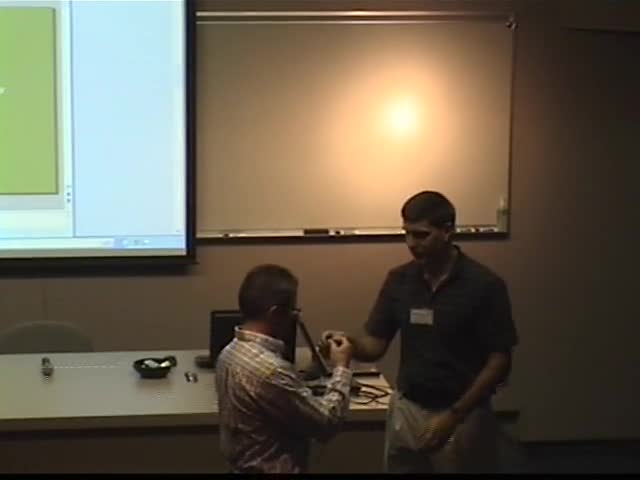Team 1: Tensor tomography of stress-induced birefringence in commercial glasses
Presenter
August 5, 2009
Keywords:
- Tensor analysis
MSC:
- 53A45
Abstract
Project Description:
Birefringence refers to
a different index of refraction for orthogonal light polarizations in
a transparent material. In stress-free glasses (which are isotropic
and can be made homogeneous) the birefringence is zero by symmetry.
When such a glass is subjected to stress, even by squeezing with your
fingers, stress-induced birefringence is readily observed. In real
glasses a certain amount of stress is unavoidably frozen in during
glass forming. It is of interest in a number of applications needing
low or nearly zero birefringence to control and minimize the level of
frozen-in stress birefringence.
The goal of this
project is to develop computational tools in Matlab to read limited
sets of birefringence measurements and approximately reconstruct a
stress distribution within the glass part that would be consistent
with the measured birefringence scans. The general mathematical
jargon for this procedure is "tensor tomography," but we are not
trying to solve the problem at its most exact and sophisticated
level. Instead we seek to make the absolutely simplest model for
stresses within a sample that is approximately or adequately
representative of the real stresses in the sample. Such an
approximate reconstruction of stress would be useful to understand
what stresses have developed in the sample and also how the
birefringence would be altered if glass were removed, changing the
stress boundary conditions. The model stress would have to obey the
usual requirements of material continuity and force balance as well
as the force-free boundary condition on the surface. Part of our
goal is to achieve an adequate approximate description of stress
using the fewest birefringence measurements possible.
We have in mind a
real-life application where reconstruction of the stress field from
limited birefringence measurements would be useful. The application
is in the manufacture of lens blanks, or blocks of extremely pure and
highly homogeneous glass used to make the diffraction-limited optics
for computer chip manufacture. Here the problem is fully
three-dimensional, and at minimum several directions of birefringence
measurement will be required.
I am interested in
possibly using Green function methods to solve for a stress
distribution based on a set of initial strains. The strain field
would constitute the unknown degrees of freedom for which we solve.
This would automatically satisfy material continuity and force
balance within the interior, and can be arranged also to satisfy the
boundary conditions on faces. However, we may elect to pursue finite
element methods or other choices depending on student interests and
experience.
References:
Background on linear
elastic theory and stress-induced birefringence can be found in many
sources, including the web or textbooks in your university library.
Note that we will work only in the linear regime and only with
perfectly isotropic and homogeneous samples (when in their
stress-free condition), so much of the mathematics is simplified.
1. One useful set of notes on linear elastic theory can be found at
http://www.engin.brown.edu/courses/en224.
See the Lecture Notes and especially the "Kelvin solution" of
section 3.2 which is the basis of the Green function method.
2. Some basics of
birefringence are included in the IMA Mathematical Modeling in
Industry Workshop 2006 report found at
http://www.ima.umn.edu/2005-2006/MM8.9-18.06/abstracts.html.
See the link to the "Team 1 report" pdf .
Prerequisites:
Required:
computing skills, numerical analysis skills, familiarity with Fourier
analysis and convolution, ability to manipulate data arrays.
Desired: some optics,
some physics, familiarity with continuum elastic theory (stress and
strain); the needed optical and glass-forming background will be
supplied.
Keywords:stress-induced birefringence, optical
properties of glass, data analysis algorithms, tensor tomography,
linear elastic theory
